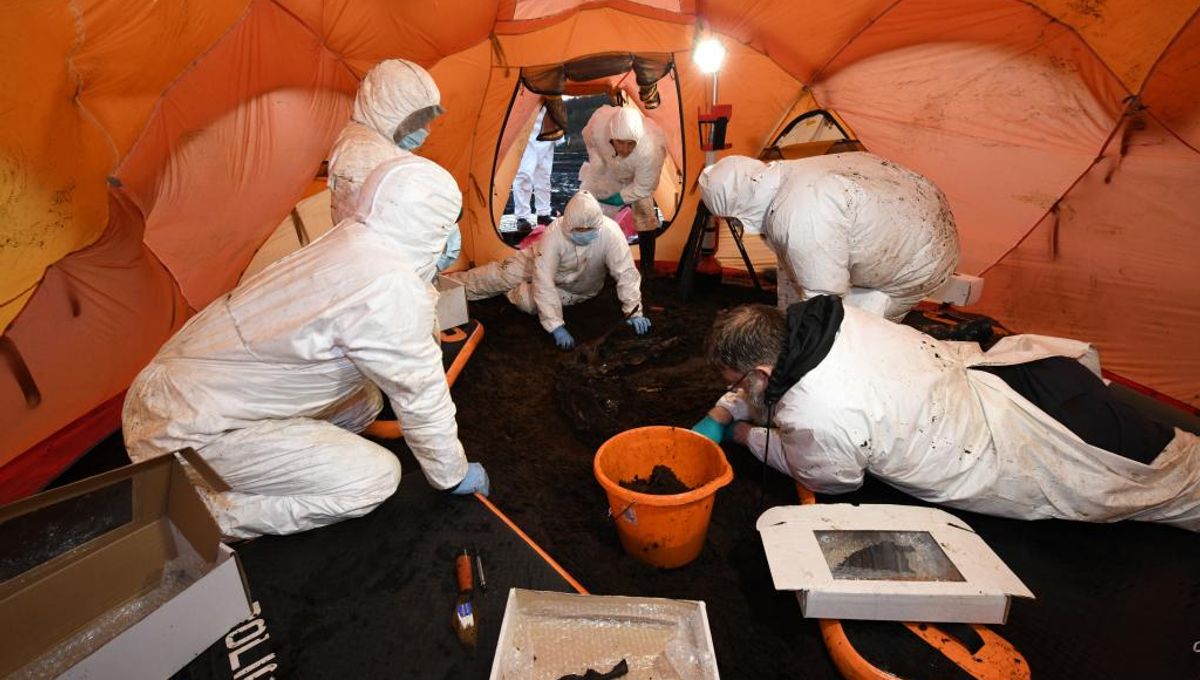
Human remains that are over 2,000 to 2,500 years old have been recovered by archaeologists within the Police Service of Northern Ireland (PSNI). The discovery, what is essentially a new “bog body”, was made in peatland at an excavation site in Bellaghy in October 2023. At the time, police were made aware that human bones had been found at the site and it was unclear whether they were old or more recent.
“On initial examination, we couldn’t be sure if the remains were ancient or the result of a more recent death”, Detective Inspector Nikki Deehan explained in a statement.
“Therefore, we proceeded to excavate the body with full forensic considerations in a sensitive and professional manner. This approach also ensures that any DNA evidence could be secured for any potential criminal investigation. Ultimately this wasn’t the case in this instance.”
At first, the team carrying out the excavation discovered bones from a human’s left lower leg and right arm. These included a tibia and fibula, as well as a humerus, ulna, and radius bone. As they continued to search, the team recovered more bones belonging to the same individual.
The first findings had been close to the surface, but the bones of a lower left arm and left femur were soon discovered about 5 meters (16.4 feet) south of the surface remains. Additional finger bones, fingernails, part of the left femur, and the breastbone were found upon further excavation.
Given the state of the remains, it is not possible to draw too many conclusions about the individual themselves. However, postmortem analysis conducted by a forensic anthropologist has determined that the individual was probably male, and between 13-17 years old when they died.
Bog bodies are human remains that have been naturally mummified in peat bogs, which contain acids that preserve bodies for centuries. Throughout history, thousands of people have been preserved in this way after their bodies fell into the muck, either after being murdered, sacrificed, or simply by accident.
Unlike some bog bodies, the remains of humans that are naturally mummified in peat bogs, these fragments have retained some of the individual’s skin, finger, and toenails, and maybe even a kidney.
“The well-preserved nature of the body meant radiocarbon dating could be used to ascertain the time of death,” Detective Inspector Deehan added.
“The radiocarbon dates have placed the time of death between 2,000 – 2,500 years ago, approximately 500 [BCE]. This is the first time radiocarbon dating has been used on a bog body in Northern Ireland, and the only one to still exist, making this a truly unique archaeological discovery for Northern Ireland.”
According to Dr Alastair Ruffel of Queen’s University Belfast; “To ensure the highest possible standards in forensic recovery of human remains were maintained, we conducted two phases of high-resolution ground penetrating radar survey at the site. The results showed no indications of further human remains.”
The remains were initially discovered about 1 meter (3.2 feet) below the current ground surface, which, Ruffel explained, “matches the radiocarbon estimates.” It seems the remains were also “amongst a cluster of fossil tree remains”, which suggests the individual “may have died or been buried in a copse or stand of trees, or washed in.”
The Chief Executive of Forest Services, John Joe O’Boyle, added: “Forest Service recognizes the significance of this very exciting find. This ancient bog body was discovered on land owned by the Department and we are now working with National Museums NI to transfer it to them so that they can continue with further examination and preservation of the remains.”
“I hope, in due course, the find will help us all understand better something of our very early history.”
Source Link: Human Bog Body Found By Police In Ireland Could Date Back To 500 BCE